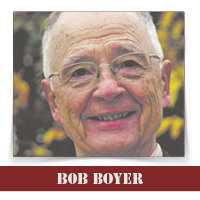By: Bob Boyer
“Discover the Philippines” is the title of a two-hour presentation I will be making at the University of Wisconsin Green Bay this coming January 20. I am looking forward to this experience. It is a one-day course offered by the university’s Learning in Retirement (LIR) Program, a wonderful outreach service to the Greater Green Bay Area. I have taught a number of courses in the program and greatly enjoy the audience: average age about 70 to 75, more women than men, and participants bring lots of experience and enthusiasm to the subject. I do, however, have a problem for which I will need your assistance, Dear Reader of this column. How can I help my students “Discover the Philippines” in just two hours? Obviously I will need to be highly selective, but in doing so, will I leave something essential out? That’s where you come in. I’m going to give you a preview, and I’m asking you to tell me if I am leaving out essentials, or, conversely, putting in nonessentials. Here’s what I wrote for the LIR Catalogue for the coming semester: “There is a saying about the colonial experience of the Philippines, that ‘it spent three hundred years in the convent and fifty years in Hollywood.’ That would have been Spain and the U.S. until independence was permanently restored in 1946. Filipino tour guides will often ask groups what are the three largest English-speaking countries in the world. The answer: U.S., Great Britain and the Philippines. The Philippines continues to be the major Southeast Asian ally for the U.S. and to be its bridge to China. Filipinos welcome American visitors and are glad to share the deliciously sunny and warm climate from December to March.” Before going any further, I need to reassert my happy amateur status as a writer about the Philippines, whether writing in this magazine, or on my <sundaysinmanila> blog, or in my book entitled Sundays in Manila. For this, I remain indebted to Professor Covar, a wonderful person and distinguished Professor of Social Anthropology whom I met at the University of the Philippines Diliman (UP). When I interviewed him for my projected book about my experiences in the country, he said, “Keep it simple. Observe, write, enjoy. Don’t try to be an anthropologist. Write about what you see and have fun.” I’ve been having fun ever since and plan to do so in the January lecture. My course description gives me a number of introductory talking points: the colonial era, independence in 1946 after the war, English speaking, and major U.S. ally in Southeast Asia. I don’t plan to spend a great deal of time but rather touch on these points to provide an overall context. I will, of course, highlight major details like the Philippine-American war of 1899-1902. Covering these points will also lead naturally to a good look at the geography. From there I can move into “My Favorite Places,” which is the heart of the lecture. “My Favorite Places” is also where I have the most difficulty with selectivity, but here is the list. In and Around Metro Manila: UP Diliman (the bright and friendly students, the welcoming faculty, and the squatter-entrepreneurs). University of Santo Tomas (founded 1610, amazing rare-book collection), the Church of Antipolo (pilgrimage site, famed statue of Our Lady of Peace and Good Voyage), Quiapo Church (always full, Statue of the Black Nazarene) Quiapo Market (also always full and fun), Intramuros (especially San Agustin and Fort Santiago), Laguna (holiday time), Tagaytay (a volcano within a volcano), Los Banos (sulfur baths and Maria Makiling), Beyond Metro Manila: Baguio (the Cordilleras), Bataan (World War II sites), Corregidor (amazing World War II tunnels), Iloilo City (Women’s Church and Babaylans), Leyte Gulf (South Pacific, Mac Arthur, rebuilding after Typhoon), Palawan (especially Puerto Princesa, Bohol (especially getting there by ferry and then visiting the Chocolate Hills). While visiting “My Favorite Places” with the students, I will note observations prompted by these visits. These observations will cover a variety of topics: food, art, strong women, religion, language, OFWs (Overseas Filipino Workers), government corruption, journalism, and the Muslim population. I will explain why I have never yet been able to visit Mindanao, something I still plan to do in the future. Recommendations please at Robert.boyer@snc.edu or <sundaysinmanila.com>.
 VIA Times – December 2014 Issue Vital News, Vibrant VIews for Asian Americans in Chicago & Midwest
VIA Times – December 2014 Issue Vital News, Vibrant VIews for Asian Americans in Chicago & Midwest



